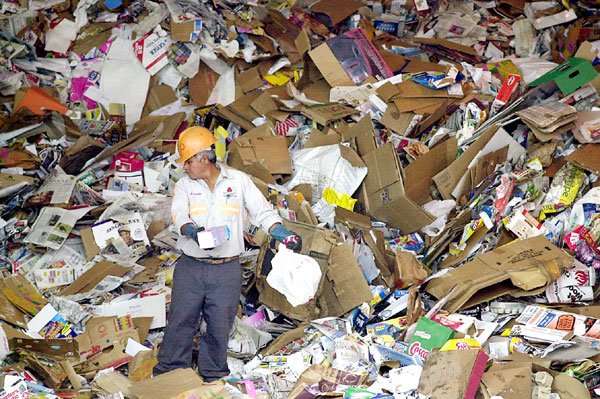GILROY
– After problems with sewer sludge fouled previous efforts to
meet state recycling mandates, the city of Gilroy is now apparently
meeting the goals – although its diversion rates are still at the
lower end of the spectrum for Santa Clara County cities.
GILROY – After problems with sewer sludge fouled previous efforts to meet state recycling mandates, the city of Gilroy is now apparently meeting the goals – although its diversion rates are still at the lower end of the spectrum for Santa Clara County cities.
Gilroy diverted 49 percent of its waste stream away from the landfill in 2000 – just a hair off the 50 percent mandated by state law – and received approval for a good-faith effort from the state’s Integrated Waste Management Board.
And preliminary 2001 projections show Gilroy meeting the state’s requirement outright at 50 percent, although those numbers won’t go before the board for certification for at least several months because of the board’s timelines.
“I’m very happy we’re at 50 percent,” said Lisa Jensema, the city’s environmental programs coordinator. “It’s a great effort, and I appreciate all of the help from businesses and residents to get us there.
“But there’s still more we can always do.”
In 1989, the state passed a law called AB 939 that gave California cities until 2000 to divert 50 percent of their refuse to other uses. Cities that fail to comply can be subjected to fines of up to $10,000 a day, although few have.
In the mid-to-late 1990s, Gilroy was getting credit for diverting only around a quarter of its waste or less – but it wasn’t because Gilroyans weren’t recycling.
While city officials said Gilroy’s combined recycling of traditional materials such as aluminum, plastic and paper products hovered near 50 percent prior to 2000, sludge from the wastewater treatment plant was preventing official recognition.
The roughly 13,000 tons of sludge generated each year from treating sewage at Morgan Hill and Gilroy’s jointly-owned plant can account for a quarter of the city’s waste. While it used to be disked into the ground, the cities began shipping it to landfills when the new treatment plant opened in 1995 – and it began counting on the state’s tally.
Because the plant is in Gilroy and the sludge is shipped from the city, Gilroy was getting docked for both its own sludge and that produced from treatment of northerly neighbor Morgan Hill’s waste as well.
“Unfortunately, that’s the way the regulations work with the waste board,” Jensema said.
Gilroy now ships the sludge to a landfill in Monterey County, where it’s used to cover other solid waste. The state allows cities to credit such use as “alternative daily cover” and it doesn’t get counted as landfilled waste in AB 939 calculations.
Another factor in the city’s increased diversion rate is the efforts of city businesses that report high volumes of recycling such as – but not limited to – Gilroy Foods, Home Depot, Goldsmith Seeds, Bonfante Gardens and area grocery stores, Jensema said.
“They’re composting a lot of produce, donating a lot of things instead of throwing them out,” she said of the grocery stores.
Gilroy residents can recycle mixed paper, newspaper, bimetals such as tin soup cans, aluminum, cardboard, glass and most plastics as well as motor oil and oil filters and yard waste.
City residents used to be able to recycle only plastics PET No. 1 and HDPE No. 2. But the city expanded the program last summer to accept Nos. 1 through 7 – which Jensema said represent more than 95 percent of the plastics consumers have access to.
Still, “I think the public is still not aware that they can recycle a lot more plastics now,” she said.
At 49 percent, Gilroy ranked 14th among Santa Clara County’s 15 cities for waste diversion in 2000. If 2001’s preliminary numbers hold, Gilroy will be somewhere in the middle of the county’s rates.
Monte Sereno, a residential suburb near Los Gatos, led at 70 percent in 2001, while San Jose diverted 64 percent. Campbell was lowest at 46 percent. Morgan Hill’s rate was 53 percent and unincorporated areas rang in at 54 percent. Concentrating on recycling at businesses – which generate close to 80 percent of the city’s waste stream – will be a key to upping the city’s rates, Jensema said.
“We just really need to get out there and make sure we’re servicing as many of the businesses as we can,” she said. “It’s a big chunk. We want to service them, or if they’re not being serviced by another contractor we want to set something up.”
Under the city’s commercial program, businesses can get containers placed and serviced free of charge outside or inside their facilities.
The city’s residential program uses a two-bin collection system where papers go in one container and all other materials except oil, oil filters and yard clippings go in the other. A 96-gallon wheeled cart is available for yard waste.
While that system has proven to be successful, the new trend is for a single-stream or one-bin systems, Jensema said. The city is talking to South Valley Disposal and Recycling about the concept, as well as batting around the idea of food-waste composting – which Jensema said would be a first in Santa Clara County.
“We’re going to be looking at that,” she said.
Other cities may have an advantage over Gilroy because they are allowed to count things Gilroy is not – such as plastic buckets or wood pallets – since Gilroy’s base waste numbers for the state were set later, Jensema said.
She speculated that the economic downturn – and subsequent closure or downsizing of Silicon Valley companies – may have also helped some cities increase their diversion rates.














